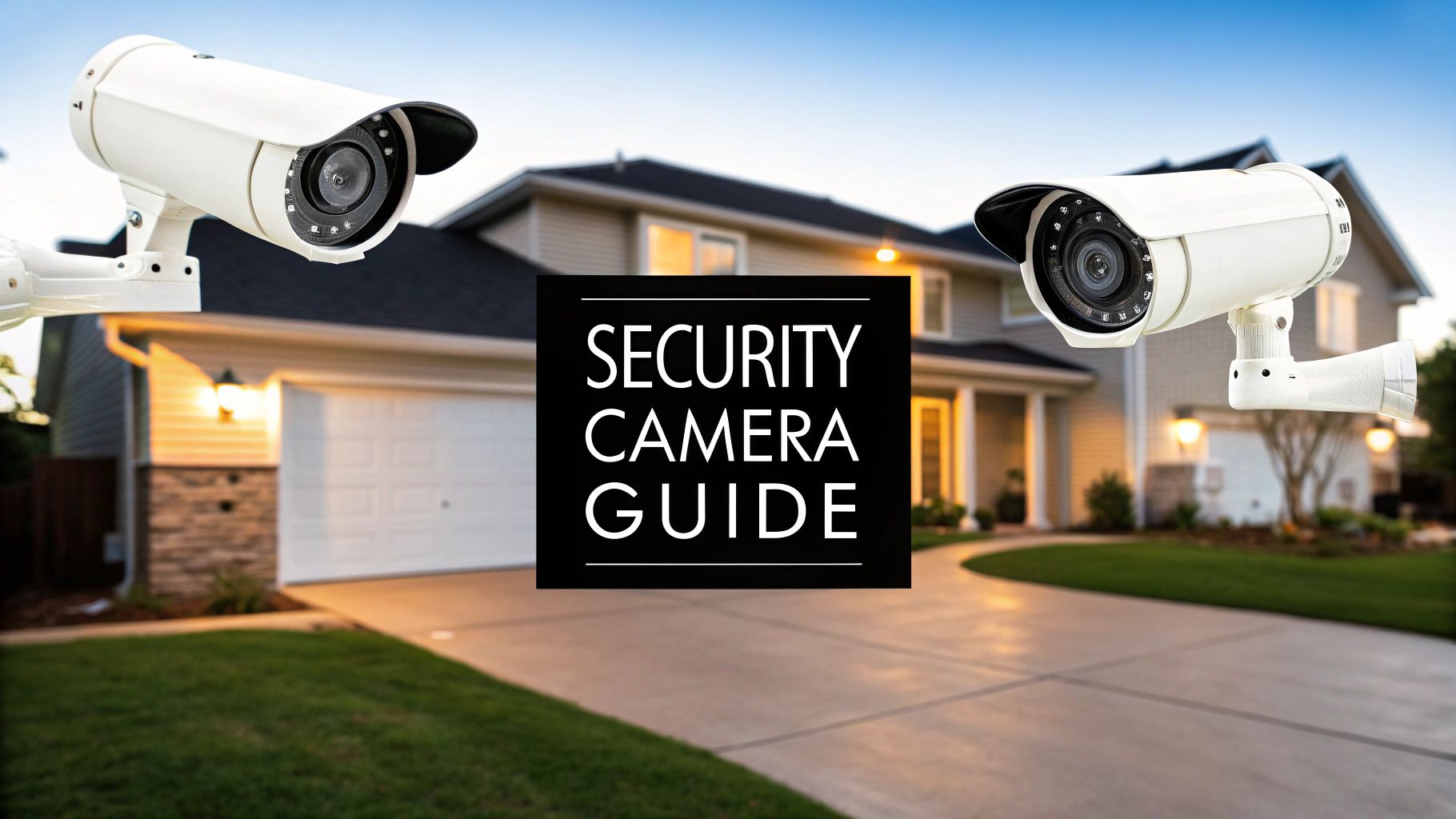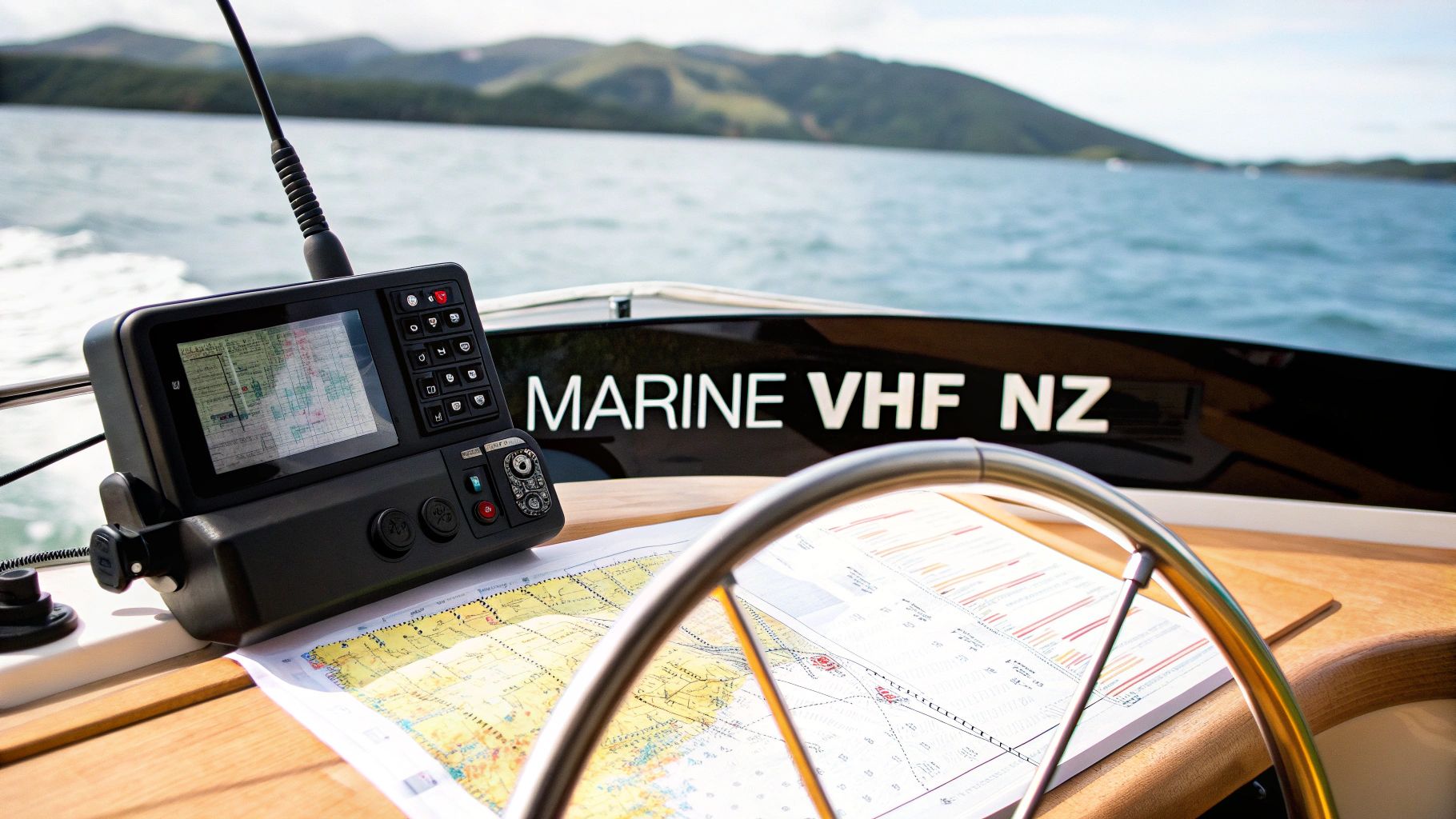Best Rural Internet Options in New Zealand 2025
Connecting the Kiwi Countryside: Your Guide to Rural Internet
Staying connected is crucial for businesses and individuals across rural New Zealand. From the Chatham Islands to Cape Reinga, reliable internet access is no longer a luxury, but a necessity. This listicle explores seven rural internet options available in Aotearoa, offering a clear breakdown of their advantages and disadvantages. Whether you're a farmer in the Waikato, a tourism operator in Fiordland, or a roading contractor in the Southern Alps, this guide offers practical insights to help you choose the best connection for your needs. We'll cover estimated pricing, coverage considerations, and potential drawbacks to help you make an informed decision. This information is vital for maintaining productivity, accessing essential services, and staying connected with the world. Finding the right rural internet option can significantly impact your operational efficiency and quality of life. Explore the options below to discover the best solution for your specific location and requirements.
1. Satellite Internet
Satellite internet offers a viable solution for rural internet options, especially in remote areas of New Zealand where traditional broadband infrastructure struggles to reach. This technology beams broadband connectivity via communication satellites orbiting the Earth. Data is transmitted between a dish installed at your property and the satellite network, bypassing the need for ground-based cables. This makes satellite internet accessible virtually anywhere in New Zealand with a clear view of the southern sky.
Several satellite internet providers operate in New Zealand, including Starlink, Farmside, and HughesNet, each with varying coverage and service plans. Starlink, popularized by Elon Musk and SpaceX, utilizes a low Earth orbit (LEO) satellite constellation, promising lower latency than traditional geostationary satellite internet. Farmside and HughesNet offer established satellite broadband services with regional availability across the country. This widespread availability makes satellite internet a particularly appealing option for those beyond the reach of fibre or fixed wireless connections. You can learn more about how Starlink works in detail through this resource: Learn more about Starlink's technology.
Key Considerations for Satellite Internet in NZ
For those considering satellite internet in New Zealand, several factors are crucial. Ensuring an unobstructed view of the southern sky is paramount for optimal signal reception. For lower latency, especially important for activities like video conferencing or online gaming, LEO satellite providers like Starlink should be explored. It’s important to closely monitor data usage, as many satellite internet plans have monthly data caps. Finally, installing surge protectors can safeguard your equipment from power fluctuations and lightning strikes, common occurrences in rural areas.
The following infographic summarizes key data points about satellite internet: Satellite Altitude, Download Speed, and Latency. This information provides a quick reference for understanding the performance characteristics of this technology.
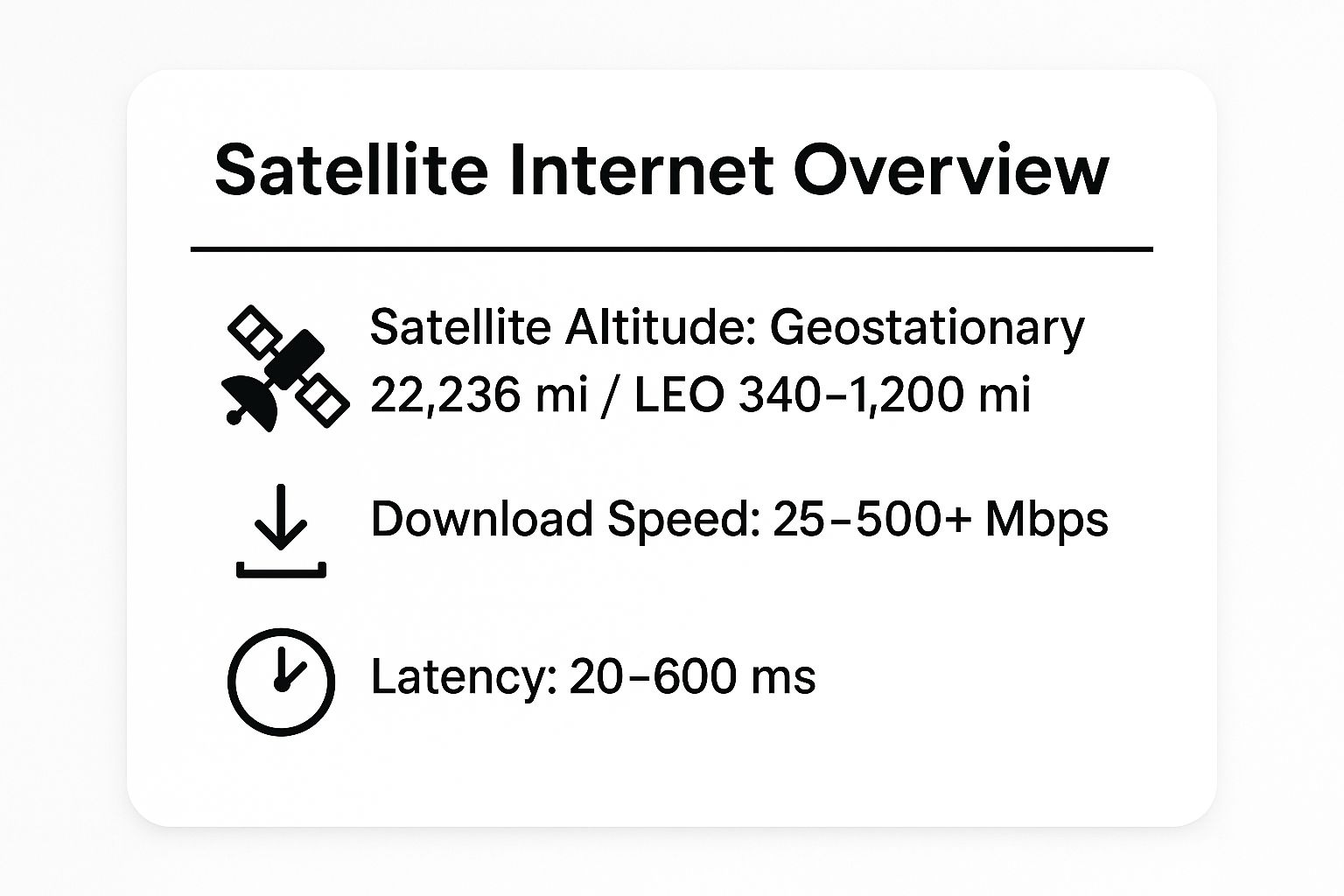
As shown in the infographic, the altitude of the satellite significantly impacts latency. Lower orbits generally result in faster speeds and reduced delay. This highlights the advantage of LEO satellite systems for applications requiring real-time responsiveness.
This video offers a visual explanation of how satellite internet functions.
Why Choose Satellite Internet?
Satellite internet holds a vital position in the list of rural internet options due to its extensive coverage. For industries operating in remote locations across New Zealand, from agriculture and horticulture to maritime operations and emergency response agencies, reliable connectivity is essential. Satellite internet delivers this crucial link, enabling businesses and individuals to stay connected even in the most isolated areas. Whether it's a packhouse needing to upload data, a tourism operator managing bookings, or a 4WD enthusiast staying in touch off the grid, satellite internet offers a solution where other options fall short. It empowers these diverse sectors to operate efficiently and maintain communication regardless of their location.
2. Fixed Wireless Internet
Fixed wireless internet offers a compelling alternative to traditional broadband for rural internet options in New Zealand. This technology uses radio waves to transmit data between a base station and a receiver installed at your property. Essentially, it creates a wireless bridge that can span several kilometers, making it a practical solution in areas where laying fibre optic cables is uneconomical or geographically challenging. This makes it particularly attractive for rural communities and businesses across New Zealand.
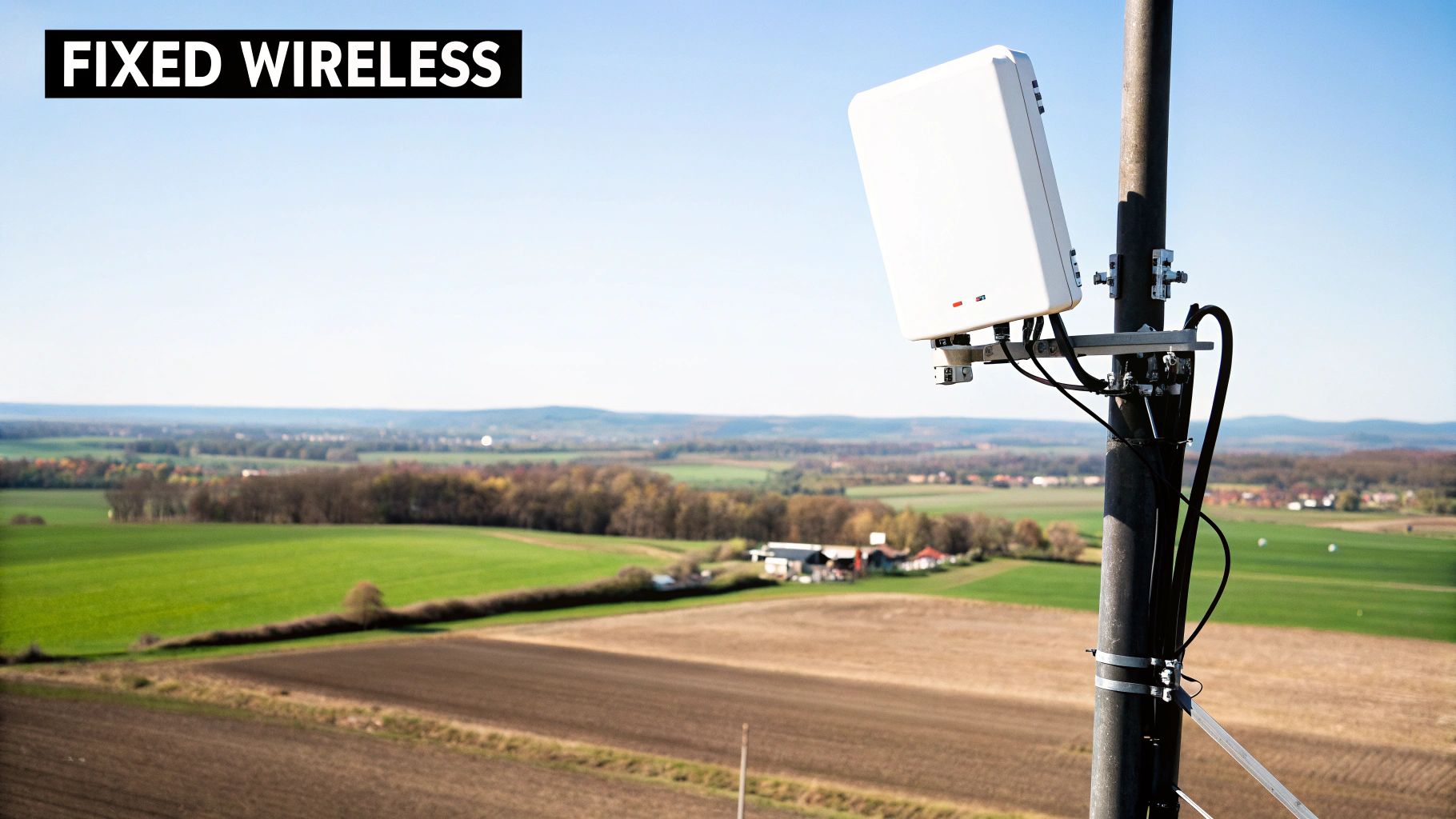
Several providers offer fixed wireless internet services throughout New Zealand, catering to both residential and business customers. While availability varies depending on your location and the provider's network coverage, it's becoming an increasingly popular rural internet option. You can learn more about suitable outdoor Wi-Fi equipment for fixed wireless deployments from this resource: Learn more about fixed wireless equipment. This technology is especially relevant for industries such as agriculture, horticulture, and tourism, which often operate in areas beyond the reach of fibre connections.
Key Considerations for Fixed Wireless in NZ
Before opting for fixed wireless internet in New Zealand, consider these crucial factors. Line of sight between your property and the base station is paramount. Obstructions like trees or buildings can significantly impact signal strength and connection stability. Therefore, a professional site survey is often recommended. Inquire about data caps and usage allowances to avoid unexpected overage charges. Understanding the service level agreement (SLA), which outlines guaranteed uptime and support response times, is essential, especially for businesses relying heavily on internet connectivity.
Why Choose Fixed Wireless Internet?
Fixed wireless earns its place among the best rural internet options due to its balance of performance, affordability, and accessibility. For many rural New Zealanders, it represents a significant upgrade from slower DSL connections or limited mobile data plans. It empowers businesses and individuals to participate in the digital economy, enabling activities like online learning, remote work, and e-commerce.
The benefits extend to specific sectors. Farmers can utilize precision agriculture technologies, optimizing irrigation and fertilizer application. Tourism operators can efficiently manage bookings and provide guests with seamless Wi-Fi access. Even 4WD enthusiasts can stay connected while exploring remote parts of the country. Fixed wireless internet bridges the digital divide, bringing reliable connectivity to those beyond the reach of traditional infrastructure.
3. DSL (Digital Subscriber Line)
DSL offers a reliable rural internet option for those located within reasonable proximity to a telephone exchange. This technology leverages existing copper telephone lines to deliver broadband internet access. It transmits data at higher frequencies than voice calls, enabling simultaneous internet and phone usage on the same line. This makes DSL accessible in many rural areas of New Zealand with pre-existing phone infrastructure. While not as ubiquitous as fibre, DSL can provide a stable connection where fibre rollout hasn't reached.
Several telecommunications providers in New Zealand offer DSL services, including Chorus and Spark. Availability and speeds can vary depending on factors like distance from the exchange and the quality of the copper lines. For those situated closer to the exchange, DSL can offer competitive speeds suitable for everyday internet use. However, those further away might experience significantly slower speeds.
Key Considerations for DSL in Rural NZ
If you're considering DSL in rural New Zealand, several factors need careful evaluation. Distance from the telephone exchange is paramount. The further away your property is, the weaker the signal and slower the speed. Before committing to a plan, inquire about the expected speed at your specific location. It’s crucial to test the actual speeds against the advertised rates once connected. Additionally, ensuring the quality of your phone line is essential for reliable DSL service. Old or damaged lines can significantly impact performance.
Why Choose DSL for Rural Internet?
DSL holds its place among rural internet options in New Zealand because of its affordability and established infrastructure. It offers a cost-effective alternative to fibre, particularly for those within a manageable distance from an exchange. For individuals and businesses operating in less remote rural areas, DSL can provide sufficient bandwidth for tasks like email, web browsing, and basic online operations. Industries like small-scale agriculture and home-based businesses may find DSL speeds adequate for their needs. It's a practical solution for those seeking a stable, affordable internet connection where fibre is unavailable or cost-prohibitive. This enables seamless communication and business operations even beyond major urban centres.
For example, a small packhouse in a rural area might find DSL sufficient for uploading daily inventory data. Similarly, a tourism operator managing online bookings might leverage DSL for smooth business operations. DSL empowers these sectors to remain connected and maintain productivity.
4. Cellular/Mobile Hotspot Internet
Cellular/mobile hotspot internet offers a practical rural internet option in New Zealand, leveraging the existing mobile phone network for broadband access. This technology utilizes 4G LTE and the increasingly prevalent 5G cellular towers to transmit data, providing connectivity in areas with adequate cell signal strength. Connecting through a smartphone, dedicated mobile hotspot device, or a cellular modem allows users to access the internet wirelessly. This flexibility makes cellular internet a convenient solution for those on the move or in locations without fixed-line infrastructure.
Several major mobile network operators in New Zealand, such as Spark, Vodafone, and 2degrees, offer data plans suitable for rural internet use. These plans range from limited data allowances to unlimited options, catering to varying usage needs. For example, Spark offers rural-focused broadband plans with larger data bundles. Vodafone provides mobile hotspot devices alongside data plans tailored for remote work and on-the-go connectivity. 2degrees also offers competitive data plans with nationwide coverage, reaching many rural communities. Comparing coverage maps from these providers is crucial for determining the best option based on your specific location.
Key Considerations for Cellular/Mobile Hotspot Internet in NZ
When considering cellular/mobile hotspot internet in New Zealand, several factors are key. Checking coverage maps from different providers is essential to ensure adequate signal strength at your location. For those in fringe coverage areas, external antennas can significantly boost signal reception. Learn more about cellular repeaters for enhanced signal strength. Understanding data usage patterns is crucial for selecting the right data plan, with unlimited options offering peace of mind for heavy users. Finally, monitoring data usage helps avoid overage charges and keeps internet costs predictable.
Why Choose Cellular/Mobile Hotspot Internet?
Cellular/mobile hotspot internet holds a significant place amongst rural internet options in New Zealand due to its portability and ease of use. For industries like transport and logistics, fleet management, and tourism, where mobility is essential, staying connected on the go is paramount. Roading contractors, 4WD enthusiasts, and outdoor adventurers can benefit from the flexibility of cellular internet, maintaining communication even in remote areas. Similarly, agricultural and horticultural businesses with mobile operations can utilize this technology for real-time data access and communication. Cellular/mobile hotspot internet empowers these sectors to operate efficiently, regardless of location, bridging the connectivity gap in rural New Zealand.
5. Fiber Optic Internet
Fiber optic internet uses thin glass or plastic cables to transmit data as light signals. This method provides the fastest and most reliable internet connection available. While traditionally limited in rural areas of New Zealand due to infrastructure costs, government initiatives like the Rural Broadband Initiative (RBI) and the Ultra-Fast Broadband (UFB) programmes, along with efforts from rural cooperatives, are expanding fiber access to previously underserved communities. This expansion is bringing the benefits of high-speed internet to more rural businesses and residents.
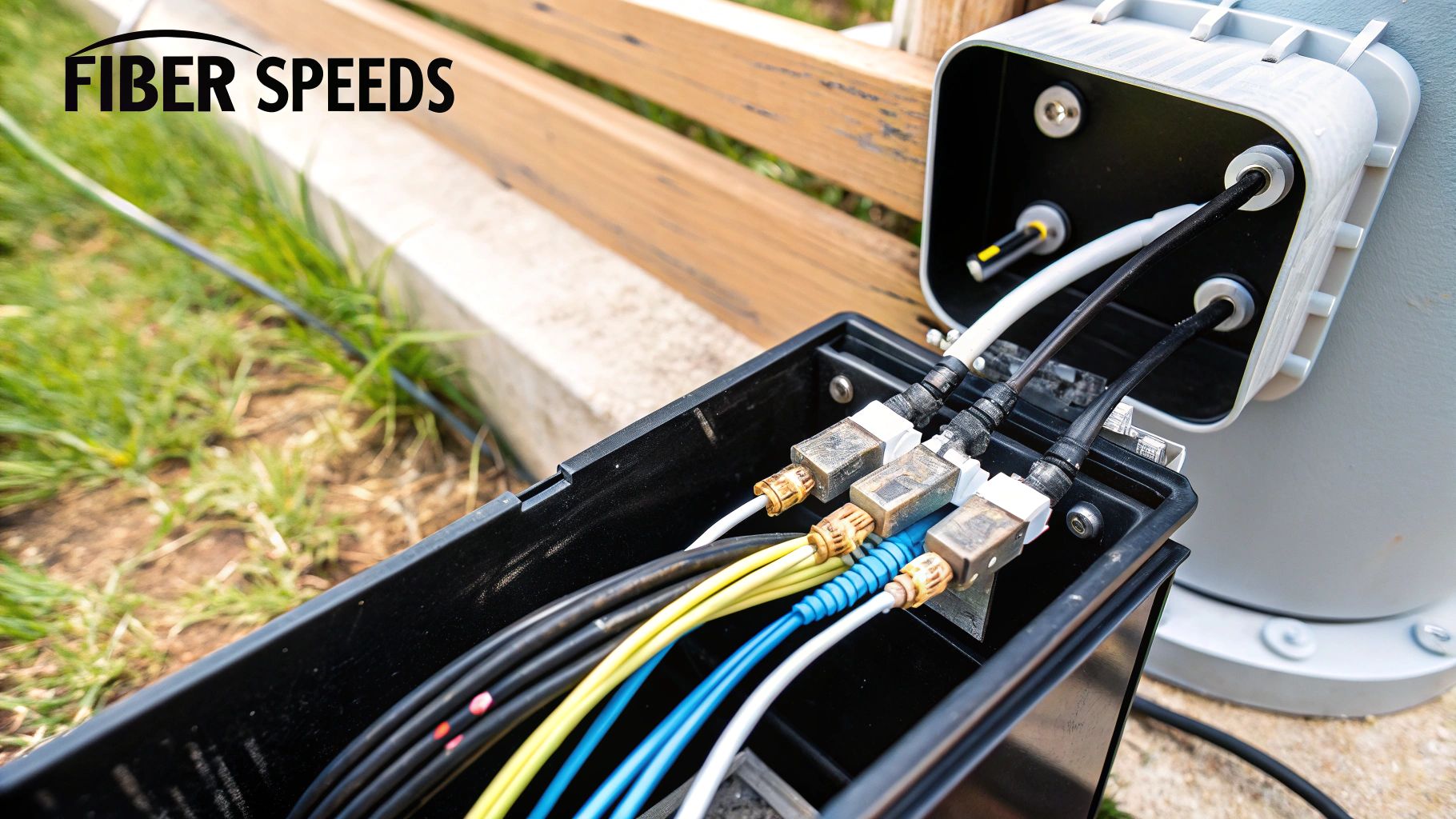
Several providers in New Zealand are actively involved in extending fiber optic networks into rural areas. Companies like Chorus and Enable are key players in the UFB rollout. Additionally, community-owned fiber initiatives are emerging in some regions, further broadening access. This increasing availability is transforming the landscape of rural internet options, providing a level of connectivity previously unavailable.
Key Considerations for Fiber Optic Internet in NZ
For those in rural New Zealand considering fiber optic internet, checking availability is the first step. Use online address checkers provided by Chorus, Enable, or your local provider to determine if fiber has reached your area. If fiber is not yet available, inquire about planned expansion projects and projected timelines. Understanding the installation process is also important, as it may involve trenching and connection to the nearest fiber node.
Why Choose Fiber Optic Internet?
Fiber optic internet offers unparalleled speed and reliability, making it the gold standard for rural internet options in New Zealand. For businesses operating in sectors like agriculture, horticulture, and tourism, the high bandwidth of fiber supports data-intensive operations, from real-time data analysis in packhouses to seamless video conferencing for tourism operators. For emergency response agencies and roading contractors, reliable communication is crucial, and fiber provides the stable connection they need. Even 4WD enthusiasts and outdoor adventurers benefit from increased connectivity for navigation, communication, and sharing their experiences.
Fiber also offers a symmetrical connection, meaning upload and download speeds are equally fast. This is vital for businesses that frequently upload large files, such as video footage or data backups. The stability and speed of fiber empower rural communities to compete on a level playing field with urban areas, fostering economic growth and enhancing quality of life. From supporting remote work and online education to enabling precision agriculture and connected healthcare, fiber is transforming how rural New Zealand lives, works, and connects.
6. Cable Internet
Cable internet utilizes existing coaxial cable networks, primarily designed for television transmission, to provide broadband internet access. This technology uses DOCSIS (Data Over Cable Service Interface Specification) to deliver high-speed internet connectivity. While traditionally more prevalent in urban and suburban areas, cable internet has extended its reach to some rural communities in New Zealand, particularly those with pre-existing cable TV infrastructure. This makes it a potential option for some rural residents seeking faster speeds than those offered by DSL or wireless alternatives.
In New Zealand, cable internet availability is less widespread than fibre or fixed wireless, primarily concentrated around urban centres. However, some smaller towns and rural areas within the vicinity of these hubs may find cable internet accessible. Providers like Vodafone offer cable services in selected areas, reaching some rural communities. It's essential to check for availability in your specific location with local providers.
Key Considerations for Cable Internet in NZ
Choosing cable internet in rural New Zealand requires careful consideration of several factors. Coverage availability is paramount. Confirm whether cable infrastructure reaches your property, as it's not as widespread as other options. Speed consistency, especially during peak usage hours, is another key consideration. Inquire with your provider about guaranteed speeds and potential slowdowns during periods of high demand. Bundle deals can offer cost savings if you also require cable television services. Finally, if using cable internet for business purposes, inquire about specific business plans designed for consistent speeds and reliable connectivity.
Why Choose Cable Internet?
Cable internet earns its place on this list of rural internet options due to its potential for higher speeds compared to DSL or some wireless connections. This is particularly relevant for rural businesses that rely on fast and reliable internet access. For example, a rural accommodation provider can efficiently manage online bookings and guest communications. Similarly, a small business operating in a rural town can leverage faster speeds for online operations, video conferencing, and data transfer. While not as universally available as other rural internet solutions, cable internet provides a viable alternative where infrastructure permits, offering a balance of speed and affordability. Remember to verify its availability in your specific rural location within New Zealand.
7. Dial-up Internet
Dial-up internet, a relic of the early internet era, utilizes existing telephone lines and modems to establish a connection. A modem converts digital computer data into audible analog signals for transmission over phone lines. At the other end, another modem converts the signals back to digital data. While largely obsolete in urban New Zealand due to the prevalence of faster broadband options, dial-up surprisingly persists as the sole internet access method in some extremely remote rural locations. This is particularly true where broadband infrastructure, like fibre or fixed wireless, hasn't reached.
Several internet service providers (ISPs) in New Zealand continue to offer dial-up services, often catering to these isolated communities. While companies like Orcon and Slingshot have phased out dial-up, smaller, local ISPs often fill the void in these underserved areas. These providers recognize the continued need for basic internet connectivity, even if limited by today's standards. Dial-up also functions as an emergency backup solution for rural businesses relying on more advanced technologies like satellite internet, offering a fallback in case of primary service disruptions.
Key Considerations for Dial-up in NZ
For those in rural New Zealand where dial-up represents the only viable option, understanding its limitations is crucial. Speeds are significantly slower compared to broadband, affecting activities like streaming and large file downloads. Dial-up also ties up the phone line, preventing simultaneous internet use and phone calls. Choosing an unlimited dial-up plan avoids per-minute charges, ensuring predictable monthly costs. Optimizing browser settings for slow connections can slightly improve the browsing experience.
Why Choose Dial-up Internet?
Despite its limitations, dial-up internet retains its relevance in the list of rural internet options for New Zealand. While not ideal for most modern online activities, it serves as a critical last resort in areas devoid of other connectivity choices. For remote farms, isolated holiday homes, or emergency communication needs, dial-up can provide a basic connection. Think of it as a lifeline for accessing essential information online, sending emails, or staying minimally connected with the world, particularly valuable for industries like agriculture and emergency services operating in extremely remote parts of the country. Dial-up ensures a minimum level of digital access where absolute disconnection isn't an option. This makes it a critical, albeit basic, tool for bridging the digital divide in rural New Zealand.
Rural Internet Options Comparison Matrix
| Internet Type | Implementation Complexity 🔄 | Resource Requirements ⚡ | Expected Outcomes 📊 | Ideal Use Cases 💡 | Key Advantages ⭐ |
|---|---|---|---|---|---|
| Satellite Internet | Moderate to High (professional dish installation, satellite access) 🔄🔄 | Moderate (satellite dish, clear sky view) ⚡ | Speeds: 25-500+ Mbps, Latency: 20-600ms 📊 | Remote locations lacking terrestrial infrastructure 💡 | Wide coverage, reliable in remote areas ⭐ |
| Fixed Wireless Internet | Moderate (line-of-sight, outdoor antenna setup) 🔄 | Moderate (antenna, modem, tower access) ⚡ | Speeds: 10-100+ Mbps, Latency: 10-50ms 📊 | Rural areas within 10-35 miles of tower 💡 | Lower latency than satellite, no data caps ⭐ |
| DSL Internet | Low to Moderate (using existing phone lines) 🔄 | Low (existing phone wiring) ⚡ | Speeds: 1-100 Mbps, distance-dependent 📊 | Areas with established telephone infrastructure 💡 | Affordable, simultaneous phone & internet use ⭐ |
| Cellular/Mobile Hotspot | Low (no installation, portable devices) 🔄 | Low (mobile device or hotspot) ⚡ | Speeds: 5-300+ Mbps, varies with coverage 📊 | Anywhere with cellular coverage, mobile users 💡 | Portable, flexible, multiple carrier options ⭐ |
| Fiber Optic Internet | High (fiber installation and infrastructure needed) 🔄🔄🔄 | High (specialized equipment, fiber cables) ⚡ | Speeds: 100 Mbps to 10+ Gbps, Latency: 1-5ms 📊 | Urban and expanding rural areas with fiber initiatives 💡 | Fastest speeds, low latency, highly reliable ⭐ |
| Cable Internet | Moderate (requires coax infrastructure) 🔄 | Moderate (coax cables, modem) ⚡ | Speeds: 10-1000+ Mbps, shared bandwidth 📊 | Areas with existing cable TV infrastructure 💡 | High speeds, bundling options, consistent performance ⭐ |
| Dial-up Internet | Very Low (basic modem & phone line) 🔄 | Very Low (telephone line, modem) ⚡ | Speeds: 28.8-56 Kbps, high latency 📊 | Extreme remote areas with no broadband options 💡 | Available anywhere, low cost, simple setup ⭐ |
Staying Connected in Rural NZ: Making the Right Choice
Navigating the landscape of rural internet options in New Zealand can feel overwhelming. From satellite connections reaching the most remote corners of the country to the potential of fibre optic cables extending their reach, understanding the nuances of each technology is crucial. This article has explored seven key internet solutions for rural NZ, each with its own set of advantages and disadvantages. We've examined satellite, fixed wireless, DSL, mobile hotspots, fibre optic, cable, and even dial-up internet, comparing their speeds, reliability, costs, and suitability for different needs.
Key Takeaways for Rural Connectivity
Remember, there's no one-size-fits-all solution. Choosing the right rural internet option depends heavily on your specific location, budget, and how you plan to use the connection. Consider the following key takeaways:
- Location is paramount: Availability of technologies like DSL, cable, and fibre often diminishes the further you are from urban centres. Satellite and fixed wireless generally offer broader coverage, while mobile hotspots depend on cellular network availability.
- Budgetary considerations: Installation costs and monthly fees can vary dramatically between different internet types. Weigh the upfront investment against long-term affordability.
- Usage patterns: High-bandwidth activities like video streaming and online gaming require a more robust connection than basic web browsing or email. Think about your current and future internet needs.
- Seeking Expert Advice: The rural internet landscape is constantly evolving. Consulting with experts can save you time and money by ensuring you select the most appropriate technology for your specific circumstances.
Empowering Your Rural Operations
Reliable internet access is no longer a luxury but a necessity, especially for businesses operating in rural New Zealand. Construction and contracting firms, maritime and fishing operators, emergency response agencies, transport and logistics companies, tourism operators, and agricultural businesses all rely heavily on seamless connectivity. Choosing the right rural internet option can significantly impact productivity, efficiency, and safety. By understanding the available options and carefully considering your specific needs, you can empower your operations and unlock the full potential of your rural business.
From staying connected with clients and managing logistics to accessing real-time data and enabling remote work, robust internet access is essential for thriving in today's digital world. Whether you're exploring the rugged landscapes of the South Island or working on a farm in the North Island, a dependable internet connection is key to success.
Don't let unreliable internet hold your business back. Mobile Systems Limited specializes in providing tailored rural internet solutions for businesses across New Zealand. Visit Mobile Systems Limited to learn how we can help you find the perfect connectivity solution for your specific needs.
